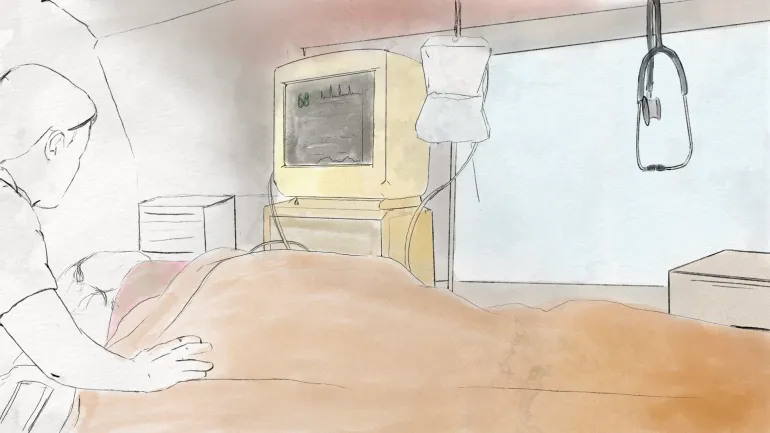Sydney Sweeney makes surprise admission about fight scenes in new boxing film & reveals horror injuries she suffered
HER face is her fortune, but Sydney Sweeney told co-stars not to hold back from punching it during her new boxing biopic.
The scenes for her role as US fighter Christy Martin may have been carefully choreographed, but they were so ferocious she suffered a bloodied nose and concussion.
The 28-year-old actress said: “The girls and all the fights you see are real. When I walked in and I met with everyone, I said, ‘I want you to hit me. And I want you to hit me hard. And can I hit you?’.
“So when you watch all those fights, we’re actually hitting each other. We were knocking each other out, we were getting bloody noses. I got concussion. We were actually fighting.”
Sydney added of co-star Katy O’Brian, who plays ring rival Lisa Holewyne: “Katy is a badass. I mean, she is strong.
“Katy’s only request was, ‘Please don’t break my nose’.”
Sydney’s childhood in Idaho saw her “kickboxing and grappling” from the age of nine to 19, which helped with the fight scenes.
But her astonishing physical transformation — putting on more than 2st of muscle over three months — was hard-earned, with up to five hours of training a day and countless protein shakes chugged.
She said: “I built my own ‘Rocky’ gym in my grandma’s shed and I trained back home in Idaho.
“I worked with my weight trainer in the morning and night, and then I had a boxing coach I worked with every day for two to three hours.
“I put on 35 pounds during that time.”
The movie, called Christy, which opens in cinemas on November 28, tells the story of WBC female super welterweight champion Christy, now 57, who was a trailblazer in the 1990s and put women’s boxing on the map.
But her biggest battle was behind closed doors, as her marriage to her older manager Jim Martin descended into violence.
When she tried to leave him in 2010, he shot and stabbed her. He was found guilty of attempted murder and died in prison last year.
But for Sydney, it was the strained scenes between Christy and her mum that she found the hardest to film.
She said: “Everything that happens within the house towards the end of the story of her life in the film weighed on me emotionally. But the one I had the hardest time doing and just processing was when she asked for her mum’s help.
“I have such amazing parents and I can go to them for anything. And I couldn’t imagine how hard it was for Christy and for others that deal with that as well.
“And it broke my heart while I was making that scene.”
As soon as Sydney heard Christy’s story, she told her team she had to have a part.
She said: “When I first read the script, I was completely blown away that I didn’t know who this woman was. She is one of the most inspiring women I’ve met in my life.”
For her part, Sydney’s grit and determination to succeed began at the age of ten, when she made a “five-year business plan presentation” to persuade her parents to let her try to become a movie star.
When they realised she was serious at 13, they made 38-hour round trips for auditions before relocating to Los Angeles to give her a better shot at stardom.
Sydney said: “It’s not easy. I didn’t get a project that helped open more doors until I was, like, 19, 20. And you get told ‘no’ endlessly by everyone.”
Sadly, her parents’ decision to relocate was a catalyst for them going bankrupt and they divorced in 2016.
But that setback only served to fuel Sydney’s drive.
She worked as a cleaner and babysitter before her break came in 2018, with roles in three big TV shows — The Handmaid’s Tale, Sharp Objects and Everything Sucks!.
A year later, she was cast as Cassie Howard in global hit Euphoria, and The White Lotus followed in 2021.
‘Really scary’
Movie hits also came with 2019’s Once Upon A Time In Hollywood, 2023’s Anyone But You and last year’s Madame Web and Immaculate.
In her love life, she has been linked to 44-year-old US record executive Scooter Braun, who she met at Amazon boss Jeff Bezos’ wedding to Lauren Sanchez in the summer.
But she has insisted: “I’m single.”
She was previously engaged to movie producer Jonathan Davino, but they split in March.
For now, she’s firmly focused on her career as it goes stratospheric.
Speculation has also been rife that, with Amazon now owning the James Bond franchise, Bezos wanted her to be a Bond Girl in the next movie.
She responded that it would depend on the script and that she would have “more fun” playing 007.
She said of her upcoming roles: “Of course I have projects that I’m working on and I’m developing and I can’t wait to do. It’s kind of like this crazy rollercoaster.
“You’re never sure if it’s going to go up or down or upside down.”
Her path to success, Sydney admits, has been a battle at times.
I was so nervous. It’s so weird when you’re playing somebody and then you meet them.
Sydney Sweeney
She said: “I know what it feels like to be underestimated, to have people define you before you have a chance to define yourself.
“I know what it feels like to have to prove that you deserve to be here, to be seen, to be taken seriously.”
During filming of the boxing biopic, Christy herself turned up every day on set with her Pomeranian emotional support dog Champ.
And Sydney has since formed a friendship with her, with the pair going to a Nascar event in Phoenix together last week.
It is a leap forward from their first meeting.
Sydney recalled: “I was so nervous. It’s so weird when you’re playing somebody and then you meet them.
“You’re like, ‘Do you like me? Are you going to like what I do?’. It’s really scary.”
And the star admits the role has made her see life differently.
She said: “I think Christy has changed me. I’m a huge believer in separating yourself as much as possible from your character.
“So that the moment they call ‘action’ and ‘cut’, you’re in and you’re out. And I go home and I’m Syd.
“But with Christy, I felt like I became the most free and powerful version of myself afterwards.”














